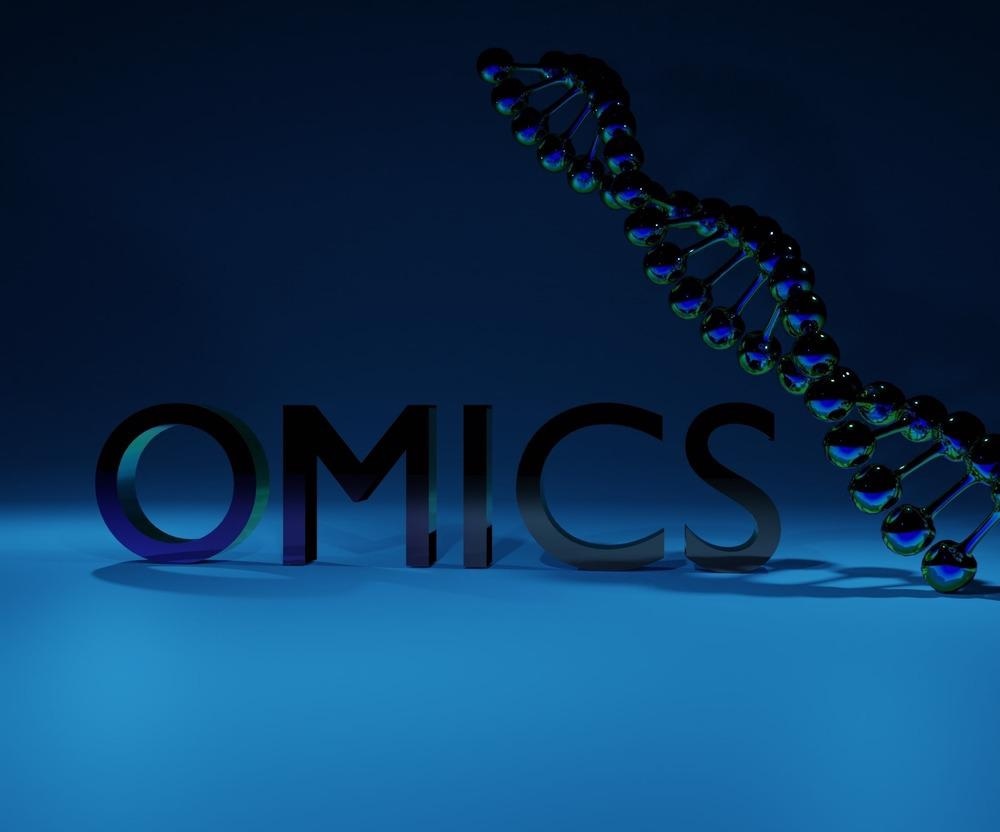Omics is a term that is used to refer to the combination of technologies used to characterize and quantify pools of biological molecules. These technologies also aid us in exploring the roles and actions of the biological molecules in the cells of living beings. Some common types of omics are proteomics (examination of proteins), metabolomics (the chemical processes involving metabolites), transcriptomics (study of RNA molecules), and genomics (detection of genes).

Image Credit: Love Employee/Shutterstock.com
The first omics technologies were the automated DNA sequencer and the ink-jet DNA synthesizer, which were developed by Leroy Hood and colleagues in the early 1990s. Around the same time, the same group of scientists introduced the protein sequencer and protein synthesizer to study proteins. Concomitantly, Frank Baganz and his group were leading the emergence of metabolomics studies.
The fundamental principle of these approaches is that a complex system can be better understood if considered as a whole. They are high-throughput biochemical assays, which measure identical molecules from a biological sample. The “omics” notion alludes to the fact that nearly all instances of the targeted molecular space are measured in a particular assay. Therefore, omics provide thorough and holistic views of a given biological system.
Genomics
Genomics (study of the genome) refers to the detailed study of the complete set of DNA in an organism. Next-generation sequencing (NGS) has been instrumental in the acquisition of genome-scale data. Scientists are now much better equipped to understand whole genomes and reduce the existing gap between genotype and phenotype.
Owing to genomics, genome-wide association studies (GWAS) have become the gold standard to detect regions, in humans and other species, associated with complex traits of interest. They can easily map causal genes with modest effects. A large number of genes are being simultaneously mapped and this can help us eliminate the drawbacks of traditional genetic association approaches, thereby, furthering our knowledge of peripartal diseases.
In the future, individual genome sequencing will help us understand the quantitative differences associated with environmental factors and, thereby, guide the design for more effective animal disease control.
Transcriptomics
The transcriptome can be defined as the complete set of RNAs being produced from the genome at a given point in time. RNA-based sequencing technologies have developed immensely, which has brought about an expansion of transcriptomics. This advancement allows for the determination of both the presence and amount of different RNA molecules.
The Columbia University’s transcriptome test, which is used in pediatric oncology cases, is an example of the clinical impact of these latest advancements. Furthermore, the recent introduction of NGS technology has revolutionized transcriptomics. It allows RNA analysis through cDNA sequencing on a massive scale and helps eliminate several challenges posed by microarray technologies. The latest advancements in RNA sequencing have also enabled the understanding of complex regulatory mechanisms (e.g., epigenetics).
Proteomics
Proteomics involves the study of the overall composition, function, structure, and interaction of the proteins that influence the activities within cells. It has brought about rapid advances in medicine.
In the case of Alzheimer’s disease, proteomics has led to the identification of proteins not previously associated with the condition. This has provided novel insights into the molecular basis of the disease and potential new diagnostic markers.
In oncology, proteomics provides information on many clinically relevant protein targets for therapeutic intervention. Proteomics is also being adopted by livestock researchers to identify and quantify protein species of complex biological samples. In terms of methods, the core of modern proteomics is mass spectrometry (MS). However, different types of liquid chromatography (LC or HPLC) are also used to create a streamed pipeline analysis and enhance automation.
Metabolomics
Metabolomics is the study of all metabolites and low molecular weight compounds contained in a particular biological specimen. Nuclear magnetic resonance imaging (NMR) and mass spectroscopy techniques are used for the analysis and current metabolomics testing can profile hundreds to thousands of metabolites.
Many diseases can be diagnosed by thoroughly analyzing the metabolome and this presents the opportunity to discover new biomarkers for therapeutic monitoring, diagnosing, and devising new therapeutic targets. The application of metabolomics in diagnostics is not new.
In the United States, a urine-based test to detect metabolites, related to pre-cancerous colorectal polyps, is licensed and is significantly more sensitive than pre-existing methods. In the case of rare diseases, there has been an exciting new development. Scientists have now adopted a mass spectroscopy approach to diagnose cholesterol storage disorder from newborn bloodspot samples. This has allowed faster diagnosis and treatment so that the disease does not worsen and bears neurological symptoms.
Conclusion and Future Research
The physiologic equilibrium is quite delicate and omics technologies have contributed widely to its understanding. The application of omics to the study of peripartal disease pathophysiology is gaining increasing popularity across the world.
Genomics England is all set to provide a big boost to the long-term research potential of the 100,000 Genomes Project. It intends to collect samples, including serum and plasma samples (proteomics and metabolomics), RNA (transcriptomics) for future use. Additionally, DNA samples are also being collected for DNA epigenetic analysis.
Driven by the success of the human genome project effort, several other omics fields have emerged, e.g., epigenomics (full set of methylation alterations in the genome), ligandomics (full set of organic small molecules), and phenomics (full set of mutational phenotypes). As the “omics” revolution gains momentum, new disciplines will become part of the biological dictionary and lead to the addition of new and high-quality molecular data.
Further Reading
Last Updated: Dec 17, 2021